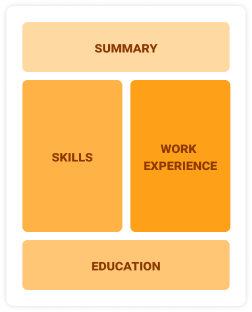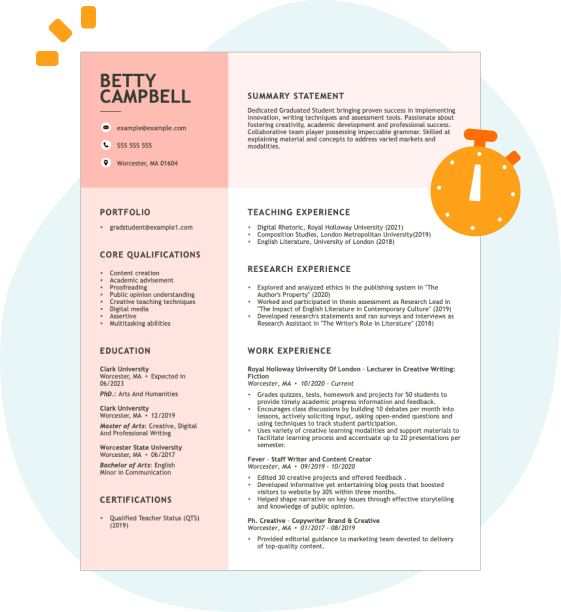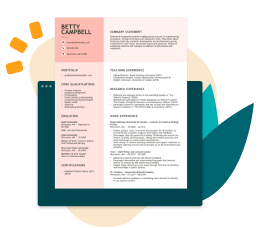Hard skills are specific competencies such as curriculum development, instructional design, and educational assessment that a director of education must possess to effectively lead educational initiatives.
Popular Director of Education Resume Examples
Discover our top director of education resume examples that emphasize critical skills like curriculum development, leadership, and educational program management. These examples will help you effectively highlight your achievements to attract the right opportunities.
Ready to design a standout resume? Our Resume Builder offers simple templates specifically crafted for education professionals, making it easier for you to shine in your job applications.
Director of education resume
This resume features a structured layout with professional resume fonts that improve readability. These design elements effectively highlight the job seeker's accomplishments and skills, making a strong impression on potential employers in the education sector.
Head of educational programs resume
This resume successfully integrates key skills like curriculum design and program development with comprehensive work experience. This combination allows employers to clearly see the job seeker's capability to lead educational initiatives while effectively managing resources and teams, highlighting a robust understanding of both strategic and practical aspects in education.
Chief academic officer resume
This resume skillfully uses bullet points to present a wealth of experience in a clear and concise manner, making it simple for hiring managers to identify key achievements. The effective spacing and structured sections improve readability, ensuring that important qualifications stand out at a quick glance.
Resume Template—Easy to Copy & Paste
Aiko Lee
Houston, TX 77004
(555)555-5555
Aiko.Lee@example.com
Skills
- Educational leadership
- Curriculum development
- Student retention strategies
- Workshop organization
- Online learning platforms
- Staff training
- Program innovation
- Instructional technology
Languages
- Spanish - Beginner (A1)
- French - Beginner (A1)
- German - Intermediate (B1)
Professional Summary
Dynamic educational leader with 5 years' expertise in driving curricular excellence and student engagement, known for innovative strategies and improving outcomes by 25%.
Work History
Director Of Education
Elite Learning Center - Houston, TX
April 2023 - October 2025
- Enhanced curriculum by 30% new courses
- Increased student retention by 15%
- Managed 20-member staff efficiently
Senior Curriculum Developer
Academic Excellence Institute - Austin, TX
January 2021 - March 2023
- Revamped syllabus led to 25% higher scores
- Coordinated 8 workshops annually
- Developed online education modules
Education Specialist
Innovative Learning Solutions - Austin, TX
January 2020 - December 2020
- Implemented tech in 10 classrooms
- Launched 5 new programs
- Trained 30 staff in modern methods
Certifications
- Certified Educational Planner - National Association for College Admission Counseling
- Digital Learning Designer - International Society for Technology in Education
Education
Master of Education Educational Leadership
Harvard University Cambridge, Massachusetts
June 2020
Bachelor of Arts Education
University of California, Berkeley Berkeley, California
June 2018
How to Write a Director of Education Resume Summary
Your resume summary is the first impression you make on hiring managers, making it important to showcase your qualifications effectively. As a director of education, you should emphasize your leadership skills, curriculum development experience, and commitment to student success.
Highlighting your expertise in educational strategies and program management will set you apart from other job seekers. This role demands an ability to inspire teams and innovate learning experiences that foster growth.
To better understand how to craft a compelling summary, review the examples provided below:
Weak resume summary
I am an experienced director of education with a passion for teaching and helping students succeed. I want to find a position where I can contribute my knowledge and have a positive impact on the educational environment. A role that values collaboration and creativity is what I’m looking for, as I believe this will help me thrive in my career.
- Lacks specific accomplishments or metrics related to educational leadership, making it vague
- Overly focuses on the job seeker’s desires rather than highlighting their unique contributions and skills
- Uses general terms like "experienced" without providing details that demonstrate expertise
Strong resume summary
Results-driven education director with over 10 years of experience in curriculum development and staff training within higher education institutions. Successfully increased student engagement by 25% through innovative teaching methodologies and technology integration. Proficient in data analysis, educational assessment, and leading cross-functional teams to improve academic programs.
- Begins with a clear indication of experience level and expertise in education
- Highlights a quantifiable achievement that showcases the impact on student outcomes
- Mentions relevant skills that align with the responsibilities of an education director
PRO TIP
Showcasing Your Work Experience
The work experience section is important on your resume as a director of education, serving as the primary focal point for your qualifications. Good resume templates always feature this section prominently to highlight your professional journey.
This part should be organized in reverse-chronological order, detailing your previous roles. Use bullet points to succinctly describe your achievements and contributions in each educational position you've held.
Now, let’s look at a couple of examples that showcase effective work history entries for directors of education. These examples will illustrate what makes an impact and what pitfalls to avoid:
Director of Education
Einstein Learning Center – New York, NY
- Oversaw programs and staff
- Managed budgets and resources
- Developed curricula for students
- Communicated with parents and community
- Lacks specific accomplishments or measurable outcomes
- Bullet points are too general and fail to highlight leadership skills
- Does not mention any initiatives or improvements made
Director of Education
Greenwood Academy – Chicago, IL
March 2020 - Present
- Develop and implement curriculum enhancements across all grade levels, leading to a 30% increase in student engagement scores
- Coordinate professional development workshops for staff, resulting in a significant boost in teaching effectiveness as evidenced by improved student performance metrics
- Foster partnerships with local organizations to create internship opportunities for students, increasing real-world learning experiences by 40%
- Uses strong action verbs to clearly outline accomplishments and responsibilities
- Incorporates specific metrics that demonstrate the impact of initiatives on the education system
- Highlights collaboration and leadership skills relevant to the role
While your resume summary and work experience are important, don't overlook the importance of additional sections. Each part of your resume contributes to a compelling narrative about your career. For detailed guidance on crafting an effective resume, explore our comprehensive guide on how to write a resume.
Top Skills to Include on Your Resume
Including a skills section on your resume is important as it allows you to showcase your qualifications at a glance. This section helps employers quickly assess if you possess the professional skills and other competencies necessary for the director of education role.
Show employers you're a well-rounded professional by showcasing hard skills and soft skills throughout your resume. While hard skills demonstrate your expertise, soft skills convey your job-relevant interpersonal abilities.
Soft skills include leadership, communication, and adaptability, which are essential for fostering collaboration among educators and ensuring a positive learning environment.
When selecting skills for your resume, it’s important to align with what employers expect from job seekers. Many organizations use automated systems that filter out applicants who lack the essential resume skills needed for the position.
To make your application stand out, thoroughly review job postings. This will help you identify which specific skills to highlight, ensuring that both recruiters and ATS systems recognize your qualifications.
PRO TIP
10 skills that appear on successful director of education resumes
Catch the attention of recruiters by highlighting key skills that are in high demand for director of education roles. You can see these skills illustrated in our resume examples, which allow you to apply with confidence backed by a professional presentation.
Here are 10 essential skills to consider incorporating into your resume if they align with your experience and the job requirements:
Leadership
Curriculum development
Instructional design
Assessment strategies
Data analysis
Communication
Collaboration
Project management
Mentoring and coaching
Technology integration
Based on analysis of 5,000+ education professional resumes from 2023-2024
Resume Format Examples
Selecting the appropriate resume format is important for a director of education, as it effectively showcases relevant leadership skills and experiences, improving your professional narrative and growth trajectory.
Functional
Focuses on skills rather than previous jobs

Best for:
Recent graduates and career changers with zero to two years of experience
Combination
Balances skills and work history equally

Best for:
Mid-career professionals focused on demonstrating their skills and pursuing growth opportunities
Chronological
Emphasizes work history in reverse order

Best for:
Leaders in educational strategy and program development.
Frequently Asked Questions
Should I include a cover letter with my director of education resume?
Absolutely, including a cover letter can significantly improve your application. It allows you to highlight your qualifications and show genuine enthusiasm for the position. If you need assistance crafting a strong cover letter, consider using our Cover Letter Generator or reviewing our comprehensive how to write a cover letter guide for tips and examples.
Can I use a resume if I’m applying internationally, or do I need a CV?
When applying for jobs outside the U.S., use a CV instead of a resume. A CV provides a comprehensive overview of your academic and professional history, which many international employers prefer. Explore our CV examples to learn about formatting and crafting an effective document tailored for global applications. Additionally, you can find tips on how to write a CV suited for international job markets.
What soft skills are important for director of educations?
Soft skills such as communication, leadership, and adaptability are essential for a director of education. These interpersonal skills foster collaboration among educators and promote a positive learning environment, ultimately improving the educational experience for both staff and students.
I’m transitioning from another field. How should I highlight my experience?
Highlight your transferable skills such as communication, project management, and adaptability from previous roles. These qualities underline your potential to excel in educational leadership, even if you lack direct experience. Share concrete examples from your past that demonstrate how these skills can effectively translate to the responsibilities of a director of education.
How do I write a resume with no experience?
If you're applying for a director of education role but lack formal work experience, don't worry. You can still craft an effective resume with no experience by highlighting relevant internships, leadership in academic projects, and any training or certifications you've completed. Express your passion for teaching and your ability to inspire others. Employers value enthusiasm and potential just as much as experience, so demonstrate what you can bring to the table.
How do I add my resume to LinkedIn?
To improve your resume's visibility on LinkedIn, add your resume to LinkedIn directly to your profile or highlight key achievements in the "About" and "Experience" sections. This approach allows education recruiters and hiring managers to easily identify qualified job seekers, increasing your chances of being discovered.







